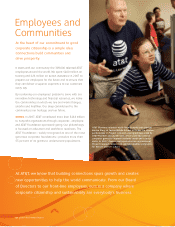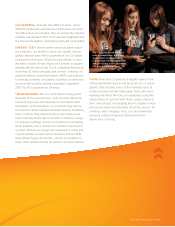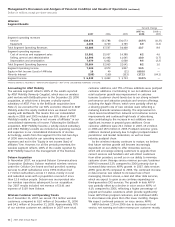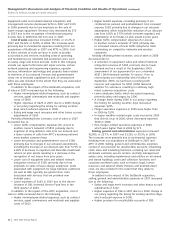AT&T Uverse 2007 Annual Report Download - page 33
Download and view the complete annual report
Please find page 33 of the 2007 AT&T Uverse annual report below. You can navigate through the pages in the report by either clicking on the pages listed below, or by using the keyword search tool below to find specific information within the annual report.
2007 AT&T Annual Report
| 31
offset by a 44.8% increase in data ARPU and increased
long-distance revenue per customer. In 2006, local service
revenue per customer declined primarily due to the two
reasons discussed above as well as free mobile-to-mobile
plans that allow our wireless customers to call other
AT&T Mobility customers at no charge and, to a lesser
extent, Rollover® minutes. An increase in customers on
Rollover plans tends to lower ARPU, since unused minutes
(and associated revenue) are deferred until subsequent
months for up to one year.
The effective management of customer churn also is
critical to our ability to maximize revenue growth and to
maintain and improve margins. Customer churn is calculated
by dividing the aggregate number of wireless customers who
cancel service during each month in a period by the total
number of wireless customers at the beginning of each month
in that period. Our customer churn rate was 1.7% in 2007,
down from 1.8% in 2006 and 2.2% in 2005. The churn rate
for postpaid customers was 1.3% in 2007, down from 1.5%
in 2006 and 1.9% in 2005. The decline in postpaid churn
reflects higher network quality, more affordable rate plans
and broader network coverage as well as exclusive devices
and free mobile-to-mobile calling among our wireless
customers. Churn levels were slightly negatively impacted
by ongoing transition of customers from our older analog
and Time Division Multiple Access (TDMA) platforms to our
advanced Global System for Mobile Communication (GSM)
network. We plan to cease operating our analog and TDMA
networks in early 2008. The increasing mix of prepaid and
reseller customers in our customer base are also expected
to pressure churn rates in the future.
Wireless Operating Results
Our wireless segment operating income margin was 16.4%
in 2007, 12.2% in 2006 and 5.3% in 2005. The higher margin
in 2007 was primarily due to revenue growth of $5,147, which
exceeded our increase in operating expenses of $2,699.
The higher margin in 2006 was primarily due to revenue
growth of $3,069, which exceeded our increase in operating
expenses of $324.
Service revenues are comprised of local voice and data
services, roaming, long-distance and other revenue. Service
revenues increased $4,890, or 14.5%, in 2007 and $3,115,
or 10.2%, in 2006 and consisted of:
• Data revenue increases of $2,692, or 63.3%, in 2007
and $1,579, or 59.0%, in 2006. The increase in 2007 is
primarily due to the increased number of data users
and an increase in data ARPU of 46.9%, which primarily
resulted from increased use of text messaging, e-mail,
data access and media bundling services. Our significant
data growth also reflects an increased number of
subscribers using our 3G network. The increase in
2006 was related to increased use of text messaging
and Internet access services, which resulted in an
increase in data ARPU of 44.8%. Data service revenues
represented approximately 18.0% of our wireless
segment service revenues in 2007 and 12.6% in 2006.
• Voice revenue increases of $2,135, or 7.3%, in 2007
and $1,592, or 5.8%, in 2006. The increase in 2007 was
primarily due to an increase in the number of average
wireless customers of approximately 12.1%, partially
offset by a decline in voice ARPU of 4.1%. The increase
in 2006 was primarily due to an increase in the average
number of wireless customers of 11.5%, partially offset
by competitive pricing pressures and the impact of
various all-inclusive calling and prepaid plans. Included
in voice revenues for both periods were increases in
long-distance and net roaming revenue due to increased
international usage.
Equipment revenues increased $257, or 6.9%, in 2007 and
decreased $46, or 1.2%, in 2006. The increase in 2007 was
due to higher handset revenues reflecting increased gross
customer additions and customer upgrades to more advanced
handsets, partially offset by increased equipment discounts
and rebate activity. The slight decrease in 2006 was due to a
decline in handset revenues as a result of increased rebates
and equipment return credits and lower priced handsets,
mostly offset by increased sales of handset units, handset
upgrades and accessories.
Cost of services and equipment sales expenses increased
$934, or 6.2%, in 2007 and $669, or 4.6%, in 2006. The 2007
increase was primarily due to increased equipment sales
expense of $1,140 due to the overall increase in sales as well
as an increase in sales of higher-cost 3G devices, the intro-
duction of the Apple iPhone handset and an increase in the
number and per-unit cost of handset accessory sales. Total
equipment costs continue to be higher than equipment
revenues due to the sale of handsets below cost, through
direct sales sources, to customers who committed to one-year
or two-year contracts or in connection with other promotions.
Cost of services declined $206 in 2007. This decline was
due to lower interconnect, roaming and long-distance
expenses related to network and systems integration and
cost-reduction initiatives, as well as cost reductions from the
continued migration of network usage from the T-Mobile
USA (T-Mobile) network in California and Nevada to our
networks in these states. Our remaining purchase
commitment to T-Mobile for this transition period was
$51 at December 31, 2007. These decreases were partially
offset by higher network usage, with increases in total system
minutes of use (MOU) of 13.5%, and associated network
system expansion and increased network equipment costs.
Expenses increased in 2006 primarily due to increases in
network usage and associated network system expansion.
Cost of services increased $492, or 5.3%, in 2006 due to
the following:
• Increases in network usage with a total system MOU
increase of 20.6% related to the increase in customers.
Additionally, average MOUs per customer increased 8.2%.
• Higher roaming and long-distance costs, partially offset
by a decline in reseller expenses. The reseller decrease
resulted from a decrease in MOUs on the T-Mobile
network of more than 50% for 2006.
• Integration costs, primarily for network integration,
of $229.
Equipment sales expenses increased $177, or 3.5%, in 2006
due to increased handset upgrades of 11.2% and an increase
in the average cost per upgrade and accessory sold, partially
offset by a decline in the average cost per handset sold to
new customers.
























